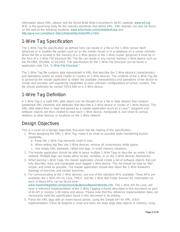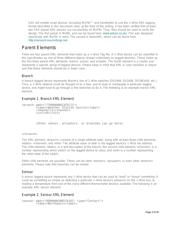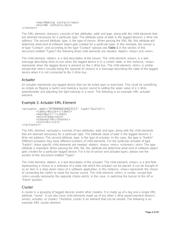下载

Maxim > Design Support > Technical Documents > Application Notes > iButton
®
> APP 158
Keywords: 1wire, 1-Wire, XML, tag, tagging, label, register, object, mechanism
APPLICATION NOTE 158
1-Wire® Tagging with XML
By: Brian Hindman, Senior Member Technical Staff, Software
Jun 07, 2002
Abstract: This document will present a 1-Wire Tag format in XML that describes the associations,
groupings, and sensing operations. The 1-Wire Tag can be thought of as data that can reside in a
traditional database, a file on a hard drive, or even in the memory of a 1-Wire device. The data indicates
the purposes of the 1-Wire device(s), their locations, and specific software classes to service and control
them. By carrying the 1-Wire Tag with a cluster of 1-Wire devices, the cluster can be self-describing and
self-configuring when presented to a new master application.
Introduction
All Maxim 1-Wire devices, including iButtons®, are individually assigned a 64-bit 1-Wire network address
number. Each number is laser engraved into the read-only memory of each device. Maxim manages this
number pool of 10
19
entries so that each device has a guaranteed unique number assigned to it.
Once these 1-Wire devices leave Maxim, most customers will associate the 1-Wire network address
number with a physical object. The number can then be placed in a database and the physical object
tracked. With the introduction of more complex 1-Wire devices that perform sophisticated sensing,
instead of just tracking the object, the object can now be analyzed or even manipulated. This, combined
with the desire to group 1-Wire devices together into a cluster to perform a group function, makes a 1-
Wire Tagging scheme desirable.
Consider the scenario where two switches are found on a 1-Wire network. One switch is used as a
branch beyond which other 1-Wire devices are located, and the other switch is used to open a high
security door. To the 1-Wire master software, it is difficult to differentiate between the two devices
without first exercising them. But, if the master software first exercises the two switches, it could
inadvertently open the high security door. Without knowing the difference between the functionality of the
two switches beforehand, the 1-Wire master software can, in the above scenario, compromise security.
The recommended way to solve this problem is through 1-Wire Tagging.
This document will present a 1-Wire Tag format that describes the aforementioned associations,
groupings, and sensing operations. The 1-Wire Tag can be thought of as data that can reside in a
traditional database, a file on a hard drive, or even in the memory of a 1-Wire device. The data indicates
the purposes of the 1-Wire device(s), their locations, and specific software classes to service and control
them. By carrying the 1-Wire Tag with a cluster of 1-Wire devices, the cluster can be self-describing and
self-configuring when presented to a new master application.
This 1-Wire Tagging scheme requires that the reader know some of the basics of XML. For more
Page 1 of 20








